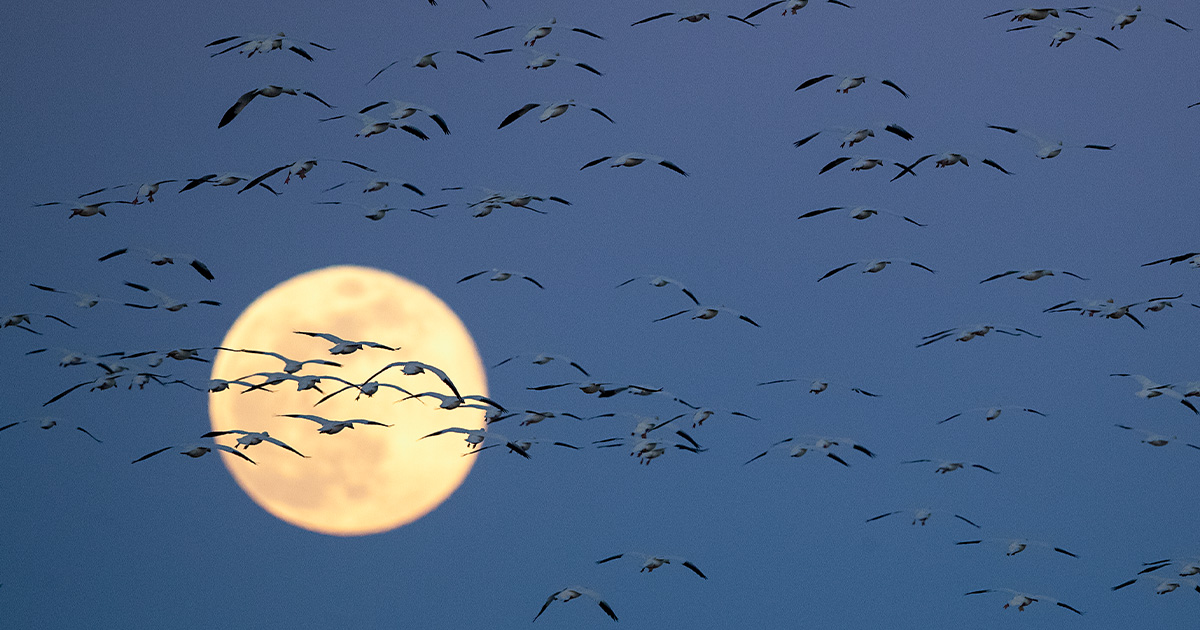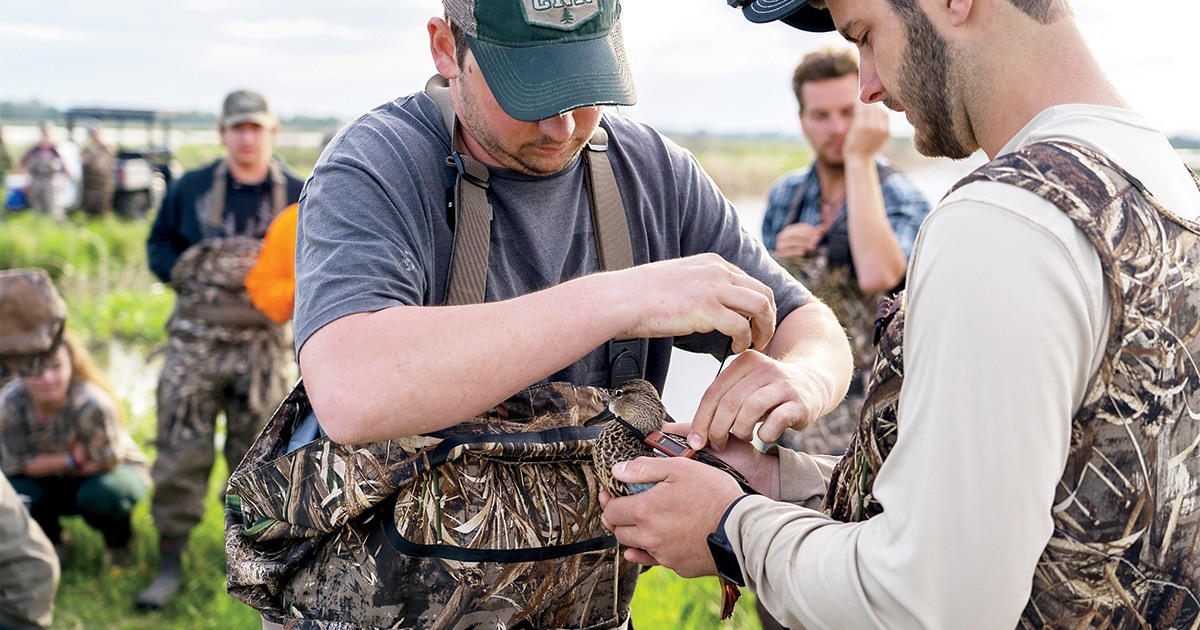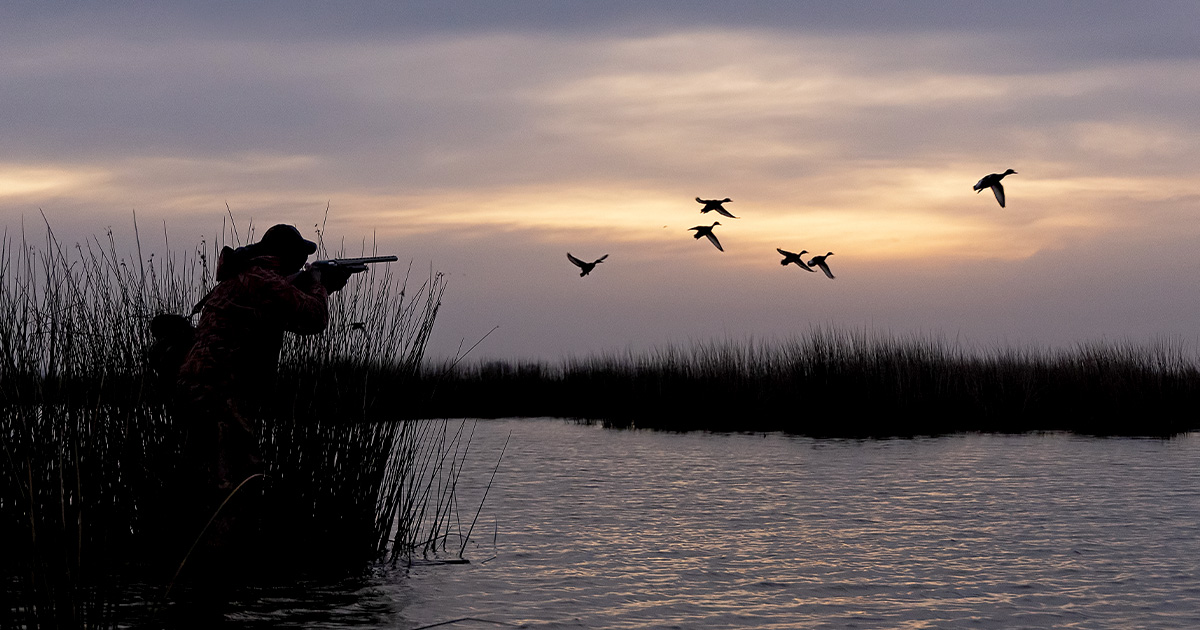The Magic of Migration
There is perhaps no greater spectacle than the grand passage of waterfowl
There is perhaps no greater spectacle than the grand passage of waterfowl

There are a lot of stories that Jeff Heidelbauer can share about his dad, but one of the most memorable is the tale of a morning hunt along a creek in central Iowa on November 11, 1940. Older generations of hunters will recognize this as the date of the famous Armistice Day Blizzard, when thousands of hunters descended on the marshes, creeks, and rivers of Minnesota, Wisconsin, Iowa, and Illinois in their canvas coats, drawn by the promise of the first significant cold front of the season. Ultimately, the storm proved deadly, killing dozens of duck hunters who were caught off guard by an unexpectedly extreme weather system. The day also produced a jaw-dropping migration of mallards, canvasbacks, and bluebills that filled the skies.
Heidelbauer’s father, Frank, said it was a sight that he would never forget. “My dad was jump-shooting mallards on Lizard Creek near Fort Dodge, and he was out in the water picking up his first greenhead of the morning when the wind suddenly hit,” Heidelbauer says. “Dad said that he saw flock after flock of mallards arriving from the north. The creek, which just moments before had been empty, suddenly filled up with mallards. His limit of greenheads came pretty quickly after that.”
Though the Armistice Day storm is one of the best-known examples of a “grand passage” of waterfowl, there have been many others across the flyways in the years since—days when the stars aligned to produce an unforgettable migration of ducks and geese. But even without the dramatic flair of birds moving en masse, there is a captivating element to every migration event. Here is a look at why and when this magic happens.
Migration is at the heart of what makes waterfowl hunting so special, but the movements of waterfowl from breeding grounds to wintering areas are also necessary for the birds’ survival.
There is one overarching cue that triggers the fall migration for all migratory waterfowl, and that is the proportion of daylight to darkness, which is known as “photoperiod.” However, changes in photoperiod affect different species of waterfowl in different ways.
Blue-winged teal are a good example. As summer winds down and the days grow shorter on the northern plains, these small grassland-nesting ducks begin staging in large flocks. And when the first cool breezes of the season stir from the north, bluewings start heading south. The predictable nature of this migration has earned blue-winged teal and other early migrants the nickname “calendar ducks.”
Ducks Unlimited’s former chief scientist, Dr. Tom Moorman, explains why the movements of bluewings and other early migrating species can be so predictable. “Blue-winged teal, which feed on seeds and invertebrates in shallow wetlands, reliably depart the breeding grounds in August and September because their preferred feeding areas are the first to freeze in the fall. This kind of response is hard-wired in waterfowl. They fuel up, store fat, and depart the breeding grounds before their food supplies are trapped under ice and snow,” Moorman says.

Blue-winged teal are among the first waterfowl species to migrate in the fall, heading south before the shallow wetlands they prefer are frozen.
Food remains a focus for teal and other waterfowl throughout the fall as the birds need to replace fat reserves that are lost during migration. Throughout their long journeys south, bluewings continue to search for shallow waters where they can find invertebrates, weed seeds, and waste grains in flooded agricultural fields. “The timing of the movements and the distances traveled by ducks and geese is related to the birds’ diets and the impact weather can have on the availability of their preferred foods,” Moorman says.
While shorter days and the first northerly breezes on cool, clear nights are enough to send blue-winged teal packing, it takes a little more to get hardier species of waterfowl like canvasbacks and bluebills moving. That’s because their food supplies are found in larger, deeper bodies of water, which take longer to freeze. “This allows these diving ducks to stay north longer and continue to build fat until extremely cold temperatures force them to migrate south,” Moorman says.
Still, even a prolonged stretch of freezing temperatures is rarely enough to push the hardiest of waterfowl out of the north. Canada geese and mallards often won’t budge until a deep layer of snow covers their food sources in fields of harvested small grains or corn. “Mallards in good condition can withstand a week without food, which allows them to wait out short periods of cold weather,” Moorman explains. “If a winter thaw occurs, they may even move back north again. This strategy enables the birds to minimize the risks associated with migration and allows them to return to the breeding grounds as soon as possible in the spring.”
At certain times, however, Mother Nature doesn’t leave waterfowl much choice, and the birds are forced to move south to find food and open water. If the movements of waterfowl were to light up on a map, there would be times when the lights would appear in short pulses. Other times, like during the Armistice Day storm, the map would glow brightly with the large-scale migrations of millions of ducks and geese. Any day when the lights go on is a good day to be in the blind to welcome new birds to the neighborhood. Conservation-minded hunters also know that to support the future of waterfowl hunting, a proper welcome includes those resources the birds need to recover from the costs of migration.

Some waterfowl species, like mallards, will stay north until snow covers their food sources and they are forced to move to warmer climates.
California’s Central Valley, the Rainwater Basin of Nebraska, the Mississippi Alluvial Valley, and Chesapeake Bay—all are historically important staging areas for migrating waterfowl. These are also places where Ducks Unlimited and its partners invest time, energy, and funds to provide the habitat and food resources that ducks and geese need to fuel their migrations and prepare them for the following breeding season.
“Migration is a pretty expensive undertaking for waterfowl in terms of energy consumed, so the focus of our work and the work of our partners is to help replenish the birds’ fat reserves, which are lost during long migration flights. We want the birds to be able to drop in and load up on food, so they are prepared for the next part of their journey,” says Dr. John Collucy, DU’s director of conservation planning in the Great Lakes/Atlantic Region. “This means conserving wetland habitats that produce annual crops of weeds and other moist-soil plants that provide waterfowl with a diverse mix of high-energy food resources.”
By pumping water or using gravity-fed irrigation systems, wetland managers can flood areas of beneficial vegetation after the growing season is complete to “set the table” for migrating waterfowl. “It’s possible to actually start putting water on these units so the food is there just as the birds are arriving,” Coluccy says. “There’s a science to it, and there’s a bit of an art to the timing of it all too.

New technologies, including lightweight radio and satellite transmitters, are helping researchers unravel the mysteries of migration.
“It is important to note that while some of this work occurs on state and federal lands, much of our work also takes place on private ground,” Coluccy continues. “It just wouldn’t be possible to make progress toward our goals of conserving wetland habitat and supporting future populations of waterfowl without a strong partnership with agricultural producers and other private landowners.”
There is certainly science behind how conservation planners like Coluccy determine the most efficient and effective way to deliver the food—and energy—needed to support ducks and geese across the continent. For example, DU employs a number of cutting-edge tools to guide conservation work on migration and wintering habitats in the Atlantic Flyway, which are vital to American black ducks and many other species. Advancements in lightweight radio and satellite transmitters are helping researchers track waterfowl movements in relation to weather events in real time. Changes in habitat and agricultural practices mean that the areas where conservation planners focus their work can change, and band recovery data is one tool waterfowl managers use to identify potential changes in waterfowl distribution. DU biologists and engineers use data collected through rigorous scientific research to target wetland conservation projects to provide food resources in the places that black ducks and other waterfowl need them most.
“Ducks Unlimited is also investigating the potential of an online, citizen-based observation system, like the eBird network sponsored by Cornell University,” Coluccy says. “We’re hopeful that this might be a way to track changes in the timing and distribution of waterfowl across the entire North American continent.”

Hunters across North America eagerly anticipate the arrival of migrating waterfowl every season.
If you are new to waterfowling, you will likely never forget the first time you witness a grand passage of waterfowl filling the skies over a marsh or field. “These birds gather on the prairies of Canada or somewhere else on the northern breeding grounds, and then through some combination of the cold and snow and wind, they pick up and follow a system of navigation that’s really only known to them. And then one afternoon, under cold, clear skies, flocks of ducks just emerge from the heavens and start dropping into your hunting spot. It’s hard not to get worked up about that,” says veteran Missouri waterfowler and guide Tony Vandemore. “You dream about the migration all off-season, but it seems like you can never fully prepare yourself for the sight of those first birds, fresh from the north. It’s just awesome.”
And it is an experience that will inspire waterfowlers for generations to come. As long as people hunt ducks and geese, they will head into the marshes or fields hopeful to see the magic of migration arrive on the wings of waterfowl.
Ducks Unlimited uses cookies to enhance your browsing experience, optimize site functionality, analyze traffic, and deliver personalized advertising through third parties. By continuing to use this site, you agree to our use of cookies. View Privacy Policy